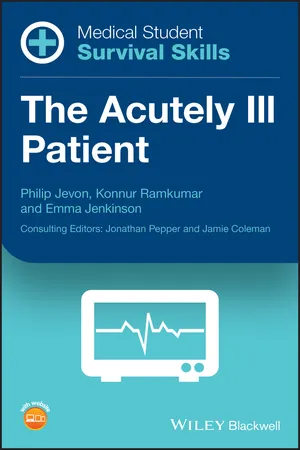
Medical Student Survival Skills
The Acutely Ill Patient
- English
- ePUB (mobile friendly)
- Available on iOS & Android
About This Book
Medical students encounter many challenges on their path to success, from managing their time, applying theory to practice, and passing exams. TheMedical Student Survival Skills series helps medical students navigate core subjects of the curriculum, providing accessible, short reference guides for OSCE preparation and hospital placements. These guides are the perfect tool for achieving clinical success.
Medical Student Survival Skills: The Acutely Ill Patient is a concise and portable reference on the management of patients in acute care settings. Managing acutely ill patients can be challenging for many medical students, where quick and decisive decision-making is crucial. This important resource covers the management of numerous acute care conditions, such as tachypnoea, acute stroke, ketoacidosis, anaphylaxis and acute liver failure. With OCSE key learning points, figures and illustrations, The Acutely Ill Patient is the key to success in emergency and surgical rotations and OCSE exams.
Frequently asked questions
Information
1
ABCDE: Assessment and treatment of the acutely Ill patient
Box 1.1 ABCDE assessment
| A | Airway |
| B | Breathing |
| C | Circulation |
| D | Disability |
| E | Exposure |
ABCDE approach: Guiding principles
- Undertake a complete initial ABCDE assessment (Box 1.1); reassess regularly
- Treat life‐threatening problems first, before proceeding to the next part of assessment.
- Evaluate the effects of treatment and/or other interventions
- Recognise the circumstances when additional help is required
- Ensure effective communication
- Call for help early (SBAR) (Box 1.2)
Box 1.2 SBAR: Structured approach to calling for help
| S | Situation |
| B | Background |
| A | Assessment |
| R | Recommendation |
Initial approach
- Ensure safe approach: check the environment and remove any hazards
- Take measures to minimise the risk of cross infection
- Ask the patient a simple question, e.g. ‘How are you, sir?’ If there is a normal verbal response the patient has a patent airway, is breathing, and has cerebral perfusion. If the patient can only speak in short sentences, they may have extreme respiratory distress, and failure to respond is a clear indicator of serious illness. If there is an inappropriate response or if there is no response, the patient may be acutely ill

- Note the general appearance of the patient, e.g. comfortable or distressed, content or concerned, colour and posture
- Attach vital signs monitoring, e.g. pulse oximetry, electrocardiogram (ECG) and continuous non‐invasive blood pressure (BP) monitoring
Airway
- Patient talking: there is a patent airway
- Complete airway obstruction: there are no breath sounds at the mouth or nose
- Partial airway obstruction: air entry diminished, often noisy breathing
- Look for the signs of airway obstruction, e.g. paradoxical chest and abdominal movements (‘see‐saw’ respirations); central cyanosis is a late sign of airway obstruction
- Gurgling: fluid in the mouth or upper airway
- Snoring: tongue partially obstructing the pharynx
- Crowing: laryngeal spasm
- Inspiratory stridor: ‘croaking respirations’ indicating partial upper airway obstruction, e.g. foreign body, laryngeal oedema
- Expiratory wheeze: noisy musical sound caused by turbulent flow of air through narrowed bronchi and bronchioles, more pronounced on expiration; causes include asthma and chronic obstructive pulmonary disease (COPD)
- Feel for signs of airway obstruction. Place your face or hand in front of ...
Table of contents
- Cover
- Table of Contents
- About the companion website
- 1 ABCDE: Assessment and treatment of the acutely Ill patient
- 2 Management of tachypnoea
- 3 Management of bradycardia
- 4 Management of sinus tachycardia
- 5 Management of other tachycardias
- 6 Management of oliguria
- 7 Management of pyrexia
- 8 Management of anaphylaxis
- 9 Management of acute asthma
- 10 Management of hypovolaemia
- 11 Management of sepsis
- 12 Management of acute stroke
- 13 Management of chest pain
- 14 Management of abdominal pain
- 15 Management of acute ischaemic leg
- 16 Management of acute kidney injury
- 17 Management of the unconscious patient
- 18 Management of upper gastrointestinal bleed
- 19 Management of diabetic ketoacidosis
- 20 Management of hypoglycaemia
- 21 Management of severe headache
- 22 Management of acute liver failure
- 23 Management of self‐harm and poisoning
- 24 Management of trauma
- 25 In‐hospital resuscitation
- References
- Index
- End User License Agreement